
JasminesFamily: N.O. Oleaceae and Jasminaceae
---Description---Their leaves are mostly ternate or pinnate; the flowers, usually white oryellow, with a tubular, five- or eight-cleft calyx, a cylindrical corolla-tube, with a spreading limb, two stamens enclosed in the corolla-tube and a two-celled ovary. ---Habitat---The COMMON WHITE JASMINE (Jasminum officinale), one of the best known and most highly esteemed of British hardy ligneous climbers, is a native of Northern India and Persia, introduced about the middle of the sixteenth century. In the centre and south of Europe it is thoroughly acclimatized. Although it grows to the height of 12 and sometimes 20 feet, its stem is feeble and requires support. Its leaves are opposite, pinnate and dark green, the leaflets are in three pairs, with an odd one and are pointed, the terminal one larger with a tapering point. The fragrant flowers bloom from June to October; and as they are found chiefly on the young shoots, the plant should only be pruned in the autumn. Varieties with golden and silver-edged leaves and one with double flowers are known. [Top] ---Medicinal Action and Uses---The roots of several species of Jasminum have had various ill-defined uses in medicine - that of J. officinale is mentioned by Millspaugh (American Medicinal Plants) as 'a proven plant' in the homoeopathic sense, though he adds: 'the authority for the use of which I am unable to determine.'
This is the Jasmine of the perfumery trade, one of the flowers most valued by perfumers, and grown at Grasse. Its delicate, sweet odour is so peculiar that it is without comparison one of the most distinct of all natural odours, and until quite recent years, it was believed that it was the only scent that could not be made artificially. A synthetic Otto of Jasmine now exists, however, its composition following more or less closely the constitution of the natural oil, containing benzyl acetate, a benzyl ester found in the natural oil of Jasmine, but the true perfume of Jasmine is not, however, exactly reproducible by any combination of chemical compounds or other natural products thus far known, and a proportion of the natural otto must be added to the mixture of synthetic substances to make the product satisfactory. This Jasmine is very extensively cultivated at Cannes and Grasse. It is not grown on its own roots, but grafted on to two-year-old plants of J. officinale, an erect bush about 3 feet high being obtained, requiring no supports. The plants are set in rows, fully exposed to the sun, in a fresh, open soil, well sheltered from north winds, as they are very susceptible to cold and readily damaged by frost. They come into full bearing the second year after grafting. The blossoms, which are very large and intensely fragrant, are produced from July till the end of October, but those of August and September are the most odoriferous, the normal harvest being generally in full swing about the middle of August. The flowers open every morning at six o'clock and are culled after sunrise, as the morning dew would injure their fragrance. An acre of land will yield about 500 lb. weight of Jasmine blossoms. A fungus, Agaricus melleus, is a plague of the Jasmine fields, attacking the roots of the grafted plants. When this mushroom has invaded a plantation, it is most difficult to combat, and the plants often have to be rooted out, causing much loss. It is not possible to grow Jasmine twice in succession on the same site, and the crop is replaced by roses or olives. The perfume is extracted by the process known as enfleurage, i.e. absorption by a fatty body, such as purified lard or olive oil. Jasmine flowers contain, when picked, only a portion of the perfume which they are capable of yielding, so fresh oil is developed by the flowers as the solvent removes what was originally present. Square glass trays, framed with wood about 3 inches deep, are spread over with grease about 1/2 inch thick, in which ridges are made to facilitate absorption, and sprinkled with freshly-gathered flowers, which are renewed every morning during the whole time the plant remains in blossom. The trays are piled up in stacks to prevent the evaporation of the aroma and finally the pomade is scraped off the glass, melted at as low a temperature as possible and strained. When oil is employed as the absorbent, coarse cotton cloths previously saturated with the finest olive oil are laid on wiregauze frames, and are repeatedly covered in the same manner with fresh flowers. They are then squeezed under a press, yielding what is termed huile antique au jasmin. Three pounds of flowers will perfume 1 lb. of grease. This is extracted by maceration in 1 pint of rectified spirit to form the 'Extract.' A small amount of Jasmine oil is prepared by extracting the blossoms with petroleum spirit and evaporating the solvent at a low temperature, but this treatment by killing the flower at once, stops the process of scent formation, so that the yield of oil is only onefifth (some say one-ninth) of that extracted by fats in the enfleurage process. The Jasmine oil obtained by extraction with volatile solvents is a pale-brown liquid with a pleasant odour, which is quite distinct, however, from that of Jasmine pomade. [Top] ---Constituents---The essential oil of J. grandiflorum contains methyl anthranilate, indol, benzyl alcohol, benzyl acetate, and the terpenes linalol and linalyl acetate. As essential oil is distilled from Jasmine in Tunis and Algeria, but its high price prevents its being used to any extent. The East Indian oil of Jasmine is a compound, largely contaminated with sandalwood-oil. Syrup of Jasmine is made by placing in a jar alternate layers of the flowers and sugar, covering the whole with wet doths and standing it in a cool place. The perfume is absorbed by the sugar, which is converted into a very palatable syrup. The ZAMBAK, or ARABIAN JASMINE (J. Sambac), is an evergreen white-flowered climber, 6 or 8 feet high, introduced into Britain in the latter part of the seventeenth century. Two varieties introduced somewhat later are respectively three-leaved and double-flowered, and these, as well as that with normal flowers, bloom throughout the greater part of the year. The Hindus string the flowers together as neck garlands for honoured guests. The flowers of one of the double varieties are held sacred to Vishnu and are used as votive offerings in Hindu religious ceremonies. At Ghazipur, a town on the Ganges, Jasmine, there called Chameli, is used mainly for making perfumed hair oils by a process of enfleurage. The odour is absorbed in sesame seeds. The seeds are prepared by washing and rubbing, and when decorticated are dried. The prepared seeds and flowers are placed in alternate layers and allowed to remain for twelve to fourteen hours. The seeds are then separated from the flowers and repeatedly treated in the same way with fresh flowers. The spent flowers are used over and over again with fresh till seeds, these latter giving oil of an inferior quality. The oil obtained from seeds treated with fresh flowers only is the best. The perfumed seeds are pressed in an ordinary wooden country press borne by bullocks. The method is crude, wasteful, tedious and dirty. Some Otto of Jasmine is also made at Ghazipur. In Borneo it is the custom among the women to roll up Jasmine blossoms in their well-oiled hair at night. [Top] ---Medicinal Action and Uses---An oil obtained by boiling the leaves of this EasternJasmine is used to anoint the head for complaints of the eye, and an oil obtained from the roots is used medicinally to arrest the secretion of milk. In China JASMINUM PANICULATUM is cultivated. It is an erect shrub, valued for its flowers and known as Sien-hing-hwa, the flowers being used with those of J. Sambac, Sambac-mo-le-hwa, in the proportion of 10 lb. of the former to 30 lb. of the latter for scenting tea, 40 lb. of the mixture being required for 100 lb. of tea. In Catalonia and in Turkey, the wood of the Jasmine is made into long, slender pipestems. JASMINUM ANGUSTIFOLIUM, an Indian species, found in the Coromandel forest and introduced into Britain during the present century, is a beautiful evergreen climber, 10 to 12 feet high, its leaves of a bright shining green, its large, terminal flowers, white with a faint tinge of red, fragrant and in bloom throughout the year. Its bitter root, ground and mixed with the powdered root of Acorus calamus, the Sweet Sedge, is in India considered a valuable external application for ringworm. In Cochin-China, a decoction of the leaves and branches of JASMINUM NERVOSUM is taken as a blood-purifier. The very bitter leaves of JASMINUM FLORIBUNDUM (called in Abyssinia, Habbez-zelim), mixed with kousso, is considered a powerful anthelmintic, especially for tapeworm; the leaves and branches are added to some fermented liquors to increase their intoxicating quality. The distinguishing characters of the TRUE YELLOW JASMINE (J. odoratissimum), a native of the Canary Islands and Madeira, consist principally in the alternate, obtuse, ternate leaves, the three-flowered terminal peduncles and the five-cleft yellow corolla, with obtuse segments. The flowers have the advantage, when dry, of retaining their natural perfume, which is suggestive of a mixture of Jasmine, jonquil and orange-blossom. Among other hardy species commonly cultivated in gardens are the low ITALIAN YELLOW-FLOWERED JASMINE (J. humile), an East Indian species, introduced into the south of Europe and now found wild there an erect shrub, 3 or 4 feet high, with angular branches alternate and mostly ternate leaves, blossoming from June to September; JASMINUM FRUTICANS (Linn.) (J. frutescens, Gueldermeister), a native of Southern Europe and the Mediterranean region, a hardy, evergreen shrub, 10 to 12 feet high, with weak, slender stems, requiring support and bearing yellow, odourless flowers from spring to autumn, and JASMINUM NUDIFLORUM (Roth.) (J. pubescens, Willd.), of China, which bears its bright yellow flowers in winter before the leaves appear. It thrives in almost any situation and grows rapidly. The important medicinal plant known in America as the 'Carolina Jasmin' (Gelsemium nitidum) is not a true Jasmine, though often called 'Yellow Jasmine.' A more correct name for it is 'False Jasmine.' The rhizome of J. fruticans is sometimes collected in the place of Gelsemium, but may be distinguished by the cells of the pith, which are thin-walled and full of starch, while those of Gelsemium are thick-walled and empty. See GELSEMIUM. From the leaves of J. fruticans, the glucoside Jasminin has been isolated, and from the shoots of J. nudiflorum, the glucoside, Jasminiflorin.
The leaves of the Indian Night Jasmine (Nyctanthes arbortristis - N.O. Jasminaceae) are used in homoeopathic medicine to make a tincture for rheumatism, sciatica and bilious fevers.--EDITOR. See INDIAN LIQUORICE. [Top] Purchase this Herb from Botanical.com © Copyright Protected 1995-2004 botanical.com
|


